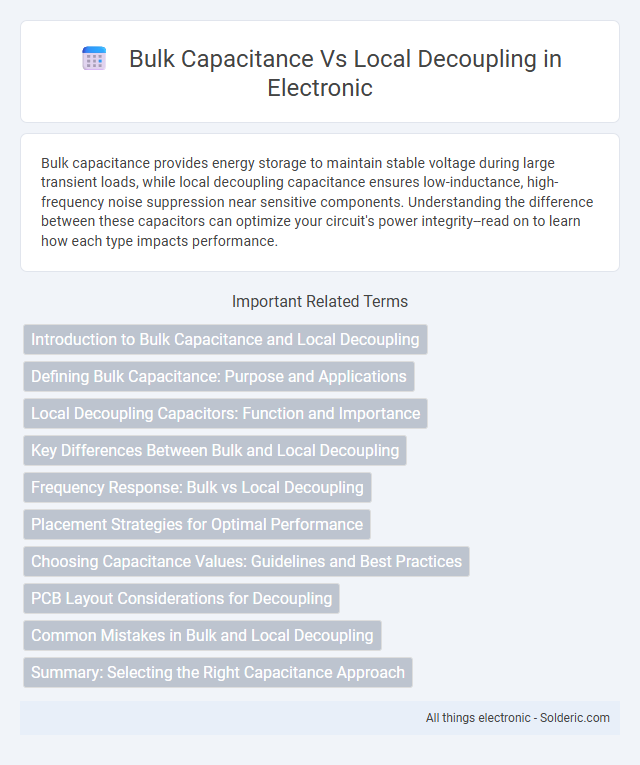Bulk capacitance provides energy storage to maintain stable voltage during large transient loads, while local decoupling capacitance ensures low-inductance, high-frequency noise suppression near sensitive components. Understanding the difference between these capacitors can optimize your circuit's power integrity--read on to learn how each type impacts performance.
Comparison Table
| Feature | Bulk Capacitance | Local Decoupling |
|---|---|---|
| Purpose | Store large energy for system-wide power stability | Reduce high-frequency noise near ICs for signal integrity |
| Capacitance Value | High (usually microfarads to millifarads) | Low (typically nanofarads to microfarads) |
| Placement | Near power supply input or on PCB power rail | Close to IC power pins, physically near load |
| Frequency Response | Effective at low frequencies | Effective at high frequencies |
| ESR and ESL | Higher Equivalent Series Resistance (ESR) and Inductance (ESL) | Low ESR and ESL for rapid transient response |
| Function in Power Integrity | Maintain steady voltage under large load changes | Suppress voltage spikes and ringing locally |
| Common Technologies | Electrolytic, Tantalum capacitors | Ceramic capacitors, multilayer |
Introduction to Bulk Capacitance and Local Decoupling
Bulk capacitance provides energy storage for maintaining voltage stability over extended periods in electronic circuits by supplying large charge reservoirs, crucial during sustained high current demands. Local decoupling capacitance minimizes voltage fluctuations near integrated circuits by offering rapid transient current delivery, reducing noise and electromagnetic interference at the component level. Effective power integrity combines bulk capacitors, typically electrolytic or polymer types, and local ceramic decoupling capacitors to balance long-term energy supply with immediate transient response.
Defining Bulk Capacitance: Purpose and Applications
Bulk capacitance refers to large-value capacitors used primarily to stabilize power supply voltages by storing and releasing energy during load transients, minimizing voltage dips across a circuit. These capacitors are essential in applications where sustained energy delivery is needed, such as power rails for microprocessors or high-current devices. Your design benefits from bulk capacitance by maintaining overall voltage stability while local decoupling capacitors handle high-frequency noise near sensitive components.
Local Decoupling Capacitors: Function and Importance
Local decoupling capacitors minimize voltage fluctuations by providing immediate charge near integrated circuits, ensuring stable power delivery during transient load changes. Positioned close to the ICs, these capacitors reduce noise and electromagnetic interference, improving overall circuit performance and signal integrity. Their low equivalent series inductance (ESL) and rapid response time are crucial for high-frequency applications and reliable electronic device operation.
Key Differences Between Bulk and Local Decoupling
Bulk capacitance provides large energy storage to stabilize the overall power supply voltage across the entire circuit board, primarily addressing low-frequency voltage drops and transient currents. Local decoupling capacitors are placed close to individual IC pins to filter high-frequency noise and provide immediate charge delivery to digital components, minimizing voltage fluctuations at the device level. The key difference lies in their frequency response and placement: bulk capacitors handle low-frequency bulk energy demands, while local decoupling capacitors focus on high-frequency noise suppression near sensitive components.
Frequency Response: Bulk vs Local Decoupling
Bulk capacitance provides energy storage with low-frequency response, effectively stabilizing voltage during large, slow load changes, while local decoupling capacitors target high-frequency transient currents near ICs, minimizing voltage ripple in fast switching circuits. The frequency response of bulk capacitors typically ranges from a few Hz to tens of kHz, whereas local decoupling capacitors operate efficiently in the MHz range, addressing rapid switching noise. Your design benefits from combining both types to ensure a stable power supply across a broad frequency spectrum.
Placement Strategies for Optimal Performance
Bulk capacitance should be placed close to the power source or entry point on the PCB to stabilize the overall voltage supply and handle large transient currents. Local decoupling capacitors must be positioned as near as possible to each IC's power pins to minimize inductance and provide immediate current during switching events. Your optimal performance depends on a balanced placement strategy that leverages bulk capacitors for global stability and local capacitors for transient response.
Choosing Capacitance Values: Guidelines and Best Practices
Selecting capacitance values for bulk and local decoupling hinges on frequency response and transient current demands. Bulk capacitors typically range from 10 uF to several hundred uF to stabilize low-frequency voltage variations and supply sustained current during load changes. Local decoupling capacitors usually fall between 0.01 uF and 1 uF to minimize high-frequency noise and provide immediate transient response near IC power pins.
PCB Layout Considerations for Decoupling
Bulk capacitance in PCB layout serves as a reservoir to stabilize voltage fluctuations and support overall power integrity during transient loads, positioned typically near the power supply entry points. Local decoupling capacitors are placed as close as possible to the integrated circuit pins to minimize parasitic inductance and provide immediate high-frequency current demands. Optimizing both bulk and local decoupling placement reduces electromagnetic interference (EMI) and ensures low impedance power delivery network (PDN) performance across a wide frequency spectrum.
Common Mistakes in Bulk and Local Decoupling
Common mistakes in bulk and local decoupling include relying too heavily on bulk capacitors to filter high-frequency noise, neglecting the placement of local decoupling capacitors near sensitive IC pins, and using capacitors with incorrect values or types that do not match the switching frequency of the circuit. You must avoid insufficient capacitor count and poor PCB layout, which can cause reduced decoupling effectiveness and increased noise coupling. Ensuring proper capacitor selection, placement, and distribution is critical to optimize power integrity and minimize voltage fluctuations.
Summary: Selecting the Right Capacitance Approach
Choosing between bulk capacitance and local decoupling hinges on your circuit's power stability needs and frequency response requirements. Bulk capacitance provides energy storage to stabilize voltage during prolonged load changes, while local decoupling targets high-frequency noise suppression near critical components. Assessing your system's transient currents and noise sensitivity ensures the right capacitance approach maximizes performance and reliability.
bulk capacitance vs local decoupling Infographic

 solderic.com
solderic.com